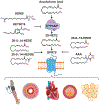20-Hydroxyeicosatetraenoic acid (20-HETE): Bioactions, receptors, vascular function, cardiometabolic disease and beyond
- PMID: 37236760
- PMCID: PMC10683332
- DOI: 10.1016/bs.apha.2023.01.002
20-Hydroxyeicosatetraenoic acid (20-HETE): Bioactions, receptors, vascular function, cardiometabolic disease and beyond
Abstract
Vascular function is dynamically regulated and dependent on a bevy of cell types and factors that work in concert across the vasculature. The vasoactive eicosanoid, 20-Hydroxyeicosatetraenoic acid (20-HETE) is a key player in this system influencing the sensitivity of the vasculature to constrictor stimuli, regulating endothelial function, and influencing the renin angiotensin system (RAS), as well as being a driver of vascular remodeling independent of blood pressure elevations. Several of these bioactions are accomplished through the ligand-receptor pairing between 20-HETE and its high-affinity receptor, GPR75. This 20-HETE axis is at the root of various vascular pathologies and processes including ischemia induced angiogenesis, arteriogenesis, septic shock, hypertension, atherosclerosis, myocardial infarction and cardiometabolic diseases including diabetes and insulin resistance. Pharmacologically, several preclinical tools have been developed to disrupt the 20-HETE axis including 20-HETE synthesis inhibitors (DDMS and HET0016), synthetic 20-HETE agonist analogues (20-5,14-HEDE and 20-5,14-HEDGE) and 20-HETE receptor blockers (AAA and 20-SOLA). Systemic or cell-specific therapeutic targeting of the 20-HETE-GPR75 axis continues to be an invaluable approach as studies examine the molecular underpinnings activated by 20-HETE under various physiological settings. In particular, the development and characterization of 20-HETE receptor blockers look to be a promising new class of compounds that can provide a considerable benefit to patients suffering from these cardiovascular pathologies.
Keywords: 20-HETE; GPR40; GPR75; Obesity; Vascular function.
Copyright © 2023 Elsevier Inc. All rights reserved.
Conflict of interest statement
Conflict of interest statement The authors have declared that no conflict of interest exists.
Figures




References
-
- Agostinucci K, et al. (2022). Blockade of 20-hydroxyeicosatetraenoic acid receptor lowers blood pressure and alters vascular function in mice with smooth muscle-specific overexpression of CYP4A12-20-HETE synthase. Journal of Hypertension, 40, 498–511. 10.1097/HJH.0000000000003038. - DOI - PMC - PubMed
-
- Azcona JA, et al. (2022). Neutrophil-derived myeloperoxidase and hypochlorous acid critically contribute to 20-Hydroxyeicosatetraenoic acid increases that drive postischemic angiogenesis. The Journal of Pharmacology and Experimental Therapeutics, 381, 204–216. 10.1124/jpet.121.001036. - DOI - PMC - PubMed
Publication types
MeSH terms
Substances
Grants and funding
LinkOut - more resources
Full Text Sources
Medical

